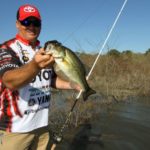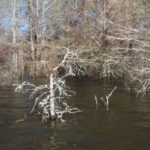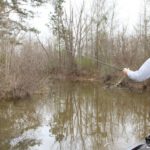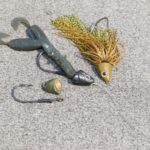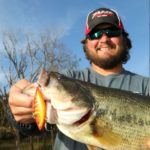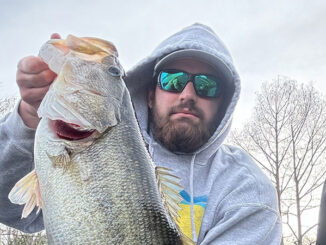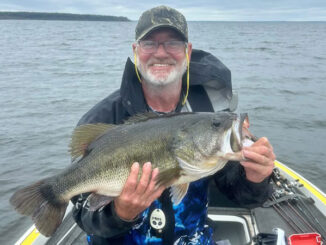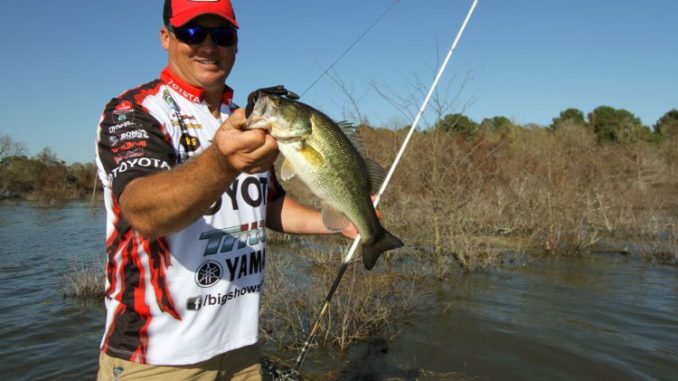
Spawning activity typically cranks up across Toledo Bend this month. Use–––– these tips to take advantage of some of the best bass fishing all year long.
Fishing the Toledo Bend spawn means different things to different folks; and not only because of bait and spot preferences. Those factors certainly matter, but so does the calendar. Fact is, this massive Sabine River reservoir holds a load of bass and they have different baby-making schedules, depending on their geographic location.
With 185,000 surface acres, Toledo Bend ranks as the nation’s fifth-largest manmade lake and in the south, she’s numero uno. Shallow and increasingly woody in its north end, deep and grassy in the south; the gem of Northwest Louisiana sprouts several main creek arms with lots of secondary arteries offering dandy bedding areas with abundant prespawn staging stuff in close proximity.
“As a rule, they spawn earlier the farther north you go; then it follows suit to mid-lake and then they spawn a little bit later the farther south you go,” said Toledo Bend guide Glen Freeman. “We have stained, muddier water in the north end and that warms up quicker. This seems to trigger them a little better. There are different factors in there, but there is definitely a wave going from the north to the south.”
With normal weather patterns, February sees the beginning of that upper-lake spawning activity. Mild years can certainly find fish moving onto beds in the second month, but the ones on their way offer a pretty incredible opportunity.
“I like to concentrate on prespawn fish and they’re going to be moving toward the mouths and mid areas of the creeks going into the spawning bays,” Freeman said. “They’re going to be on points and any kind of structure leading up to the shallow spawning areas.”
Important to note, Freeman’s not talking about main lake points; rather, he’s looking for those transitional areas coming off a bank line or at the entrance to a secondary arm. As the fish move up, they follow the contour lines, ditches, drains or whatever that leads them into the shallow bedding areas in about 6 feet of water or less. On their way up, the fish may stage on a variety of cover, from simple ledges to deeper stumps, to hay grass growing on the break lines.
Secure facility
Food-rich areas are important for these staging fish, but so is water temperature. They simply must feel an increase, or there’s no sense in progressing.
“The fish will be looking primarily for the north banks in the pockets and the coves because they’re going to warm up quicker,” Freeman said. “These spots don’t have all the west and northeast winds hitting them.”
A big fan of flipping/pitching to shallow cover, Bassmaster Elite pro Russ Lane offers this suggestion: “I look for laydowns with small holes because this gives the fish the cover they want, but it allows me to get a bait in there to them. I also want that laydown to be close to a drop-off, because big fish want to have access to deep water.”
Freeman likes seeking spawners in the bushes, but he knows this game is subject to forces beyond his control. Reservoirs are dynamic creatures and year-to-year anglers may see dramatically different Toledo Bends.
“It all comes down to water level,” Freeman said. “If the water is up and it’s in the bushes, these are key spots. If that water’s in there, the fish will be in there, no matter what. If the water’s down and it’s not in the bushes, we start looking for structure that’s out in front of the bushes — little shallow, protected areas.”
Good examples here: In the lake’s grassy south end, Freeman would look for staging fish in the grass beds outside the spawning areas. Up north, where grass is less abundant, it’s more about woody cover.
“They’ll get on the cypress root systems and the stumps; anything that protects them, away from the current,” Freeman said. “If the fish have an area with a lot of root systems and cypress knees, they will spawn on the cypress trees.
“Even if the water is in the bushes, at times, they’ll be on the trees and not in the bushes. Regardless, we’re still looking for areas protected from the wind. Also, the fish have to be away from current to spawn, so farther back in the pockets is going to be the key.”
Best baits
Lane looks for his staging fish with a Big Bite Baits Suicide Shad on an ⅛-ounce Buckeye Lures jighead. Ideally, the ruse convinces any interested parties. If not, he’ll send in the closer.
“Even if you don’t catch them, if you can make them show themselves, you can follow up with a more targeted presentation like a Texas-rigged plastic,” Lane said.
When targeting Toledo Bend bedding fish, Lane knows that the early ones can be awfully nervous. In such times, he’ll match his Big Bite trailer according to fish mood. His choices: Yo Daddy (most action), Fighting Frog (less action) and Yo Mama (no action).
“You can let the way the fish react when you trolling motor by the bed tell you which bait to use,” Lane said. “Sometimes, they’ll turn toward you as you go by and turn with you; watching you. You know those fish will bite.
“Then some will slide off the bed and slowly swim back lazily. You’ll probably catch them, too. It’s the ones that shoot off the bed as soon as they see you and stay gone that are harder to catch.”
When he’s looking for staging prespawners, Freeman likes throwing crankbaits — maybe even deep divers — to cover water and find the fish. If he’s graphing specific structure like stumps, logs, or distinctive features in a contour line, a jig can prove highly effective at tempting big bites from big fish seeking big meals.
“A Texas-rigged 6- to 8-inch lizard is one of my favorites,” Freeman said. “Also, lipless crankbaits like the Rat-L-Traps are a big deal in the prespawn. Especially if you have hydrilla or any kind of vegetation, this a great prespawn bait.”
Mind the variables
If you ever doubt that the moon literally runs the natural world, fish through quarter, new and full phases, then log your results and evaluate your findings. Not to say you won’t catch fish between the dark and bright phases, but the major pull of a full moon is the power switch for good times.
“January, February and March; as cold as it gets, we still have warm afternoons with bright, sunny days where the water temperature creeps up a little bit,” Freeman said. “We can have water temperatures in the upper 40s and low 50s, and then it comes up a degree or two.
“When I’m moving to a spawning pocket, I’m looking for the warmer water temperature. This usually happens later on, up in the day. You might pull into a place and there’s not a fish in there; but as that water temperature eases up in the afternoon, all of a sudden, they’re there.”
Now, assuming all other factors remain stable, Freeman said he’ll usually spend his February mornings looking for prespawn fish and then progress to the bedding areas as the day warms. However, he warns against holding too rigidly to such game plans.
“I’m always going to check the really shallow water in the morning, in case the water temperature stayed up overnight,” he said. “It all depends on the water temperature. If we have two or three days of warm temperature, they can stay up there, even in the mornings.”
